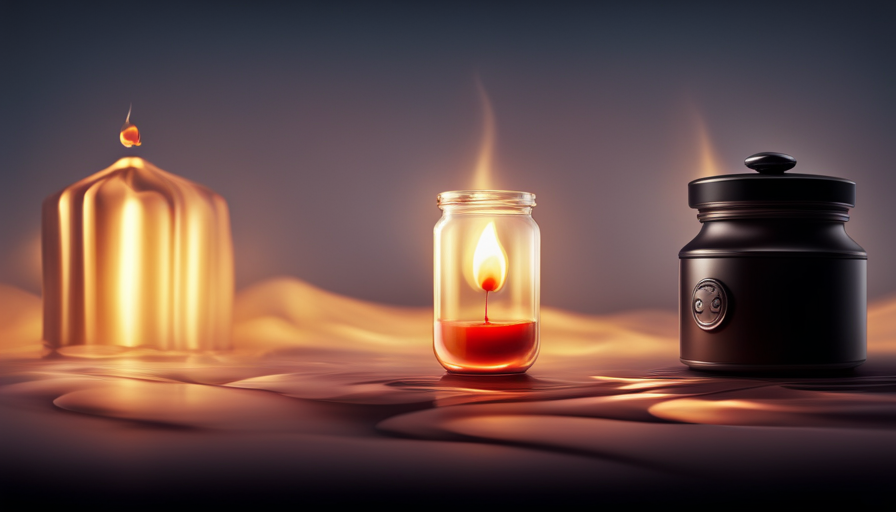Have you ever wondered about the secret behind how a candle warmer works? Let us take you on a journey to unraveling this mystery.
Candle warmers are ingenious devices that bring warmth and fragrance to your space without the need for an open flame. With their sleek designs and efficient heating mechanisms, they create a cozy ambiance while ensuring safety.
In this guide, we will explore the inner workings of a candle warmer, from the types available to the benefits they offer. We will also delve into how they prevent fire hazards and provide tips on cleaning and maintenance.
So, join us as we delve into the fascinating world of candle warmers and discover the secrets behind their mesmerizing glow.

Key Takeaways
- Candle warmers use advanced heating technology to warm the wax in the candle.
- There are different types of candle warmers, such as plate candle warmers, lamp candle warmers, and electric candle warmers.
- Candle warmers offer convenience and safety compared to traditional candle use.
- Using a candle warmer is cost-effective in the long run.
What Is a Candle Warmer
A candle warmer is a device that uses heat to release the fragrance of a candle, without the need for an open flame. This innovative invention has gained popularity among candle enthusiasts due to its numerous features and benefits.
Candle warmers come in various designs and styles, allowing users to choose the one that best suits their preferences and decor. Some models have a built-in timer, providing convenience and peace of mind by automatically turning off after a certain period.
Additionally, candle warmers eliminate the safety concerns associated with burning candles, making them an ideal choice for households with children or pets. Moreover, using a candle warmer extends the lifespan of candles, as they burn slower and more evenly, resulting in cost savings over time.
Types of Candle Warmers
There are several different types of candle warmers that we can explore to understand how they work. When choosing a candle warmer, it’s important to consider your specific needs and preferences.
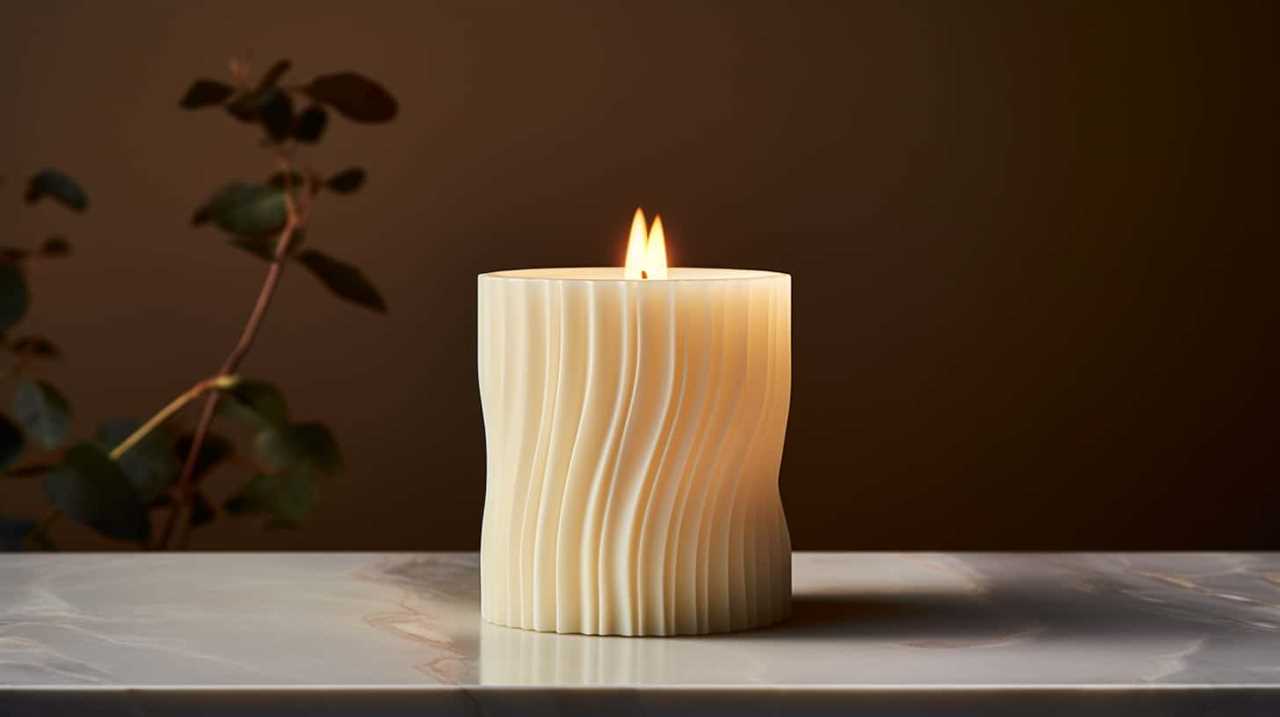
The first type is the plate candle warmer, which consists of a heating plate that warms the candle from the bottom. This type is simple and effective, providing a gentle and even heat distribution.
Another type is the lamp candle warmer, which uses a light bulb to generate heat. This type not only warms the candle but also serves as a decorative lamp.
Finally, there are candle warmers that use electricity to heat the candle. These types often come with adjustable temperature settings, allowing you to control the level of heat.
Understanding the different types of candle warmers is essential in choosing the right one for you.

Now, let’s delve into the heating mechanism used in these devices.
The Heating Mechanism
To understand the heating mechanism of candle warmers, let’s delve into how these devices generate warmth from the candle.
Candle warmers use advanced heating technology to gently warm the wax in the candle, releasing its fragrance without the need for an open flame. Here’s how it works:
- Induction heating: Some candle warmers use induction heating technology, which uses electromagnetic fields to heat the base of the warmer. The heat is then transferred to the plate on which the candle sits, warming the wax.
- Halogen bulb heating: Another common heating method in candle warmers involves the use of a halogen bulb. The bulb emits heat, which is directed towards the plate, melting the wax and releasing its scent.
When it comes to safety features, candle warmers are designed with the utmost care to ensure a secure and enjoyable experience. These features may include:
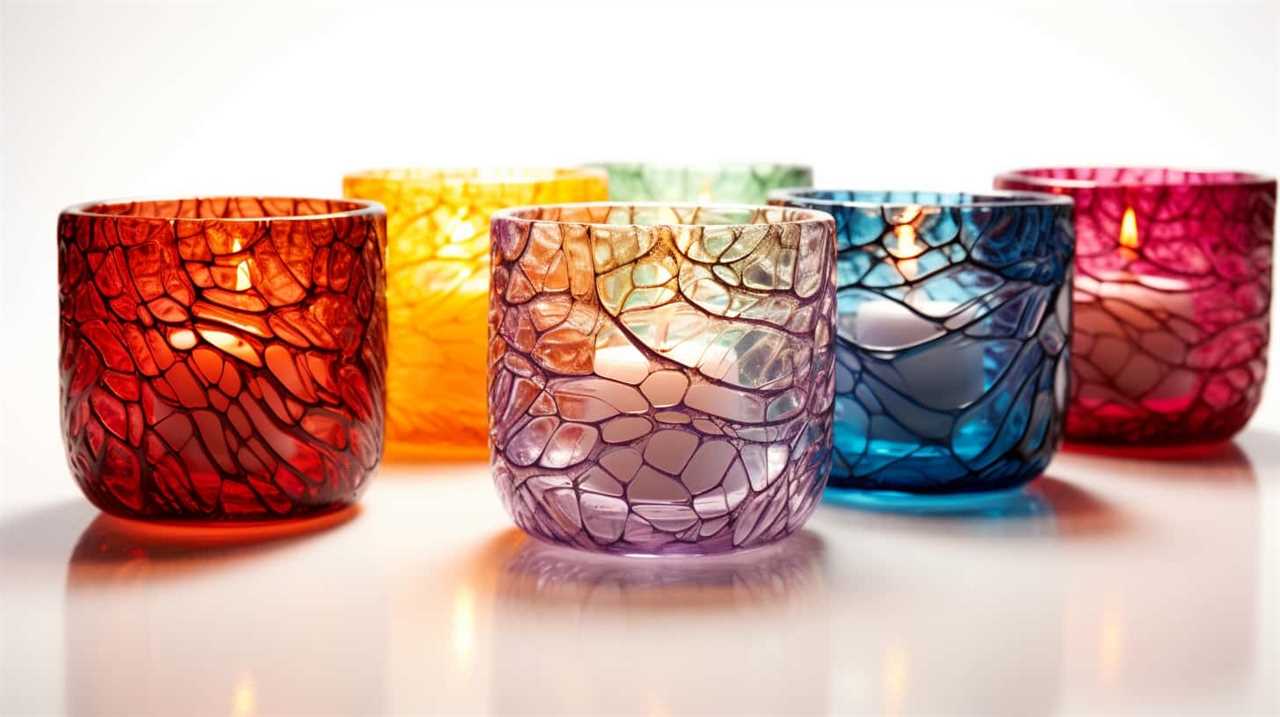
- Temperature control: Many candle warmers have adjustable temperature settings, allowing you to control the level of heat and prevent overheating.
- Automatic shut-off: Some candle warmers have a built-in timer or sensor that automatically shuts off the device after a certain period of time, providing peace of mind and preventing accidents.
Benefits of Using a Candle Warmer
As we explore the benefits of using a candle warmer, it’s important to note the convenience and safety that this innovative device offers. Compared to traditional candle use, a candle warmer eliminates the need for an open flame, reducing the risk of accidents and fire hazards. Additionally, it allows for a longer lasting fragrance experience since the candle is gently warmed rather than burned. This not only enhances the ambiance but also ensures that no wax is wasted. Moreover, candle warmers are cost-effective in the long run. While traditional candles need to be replaced once they burn down, a candle warmer can be used with different scented wax melts, making it a more economical choice. Let’s take a closer look at the benefits of using a candle warmer:
| Benefits | Description |
|---|---|
| Convenience | No need to worry about keeping an eye on a burning candle or trimming the wick. Simply plug in the candle warmer and enjoy the fragrance. |
| Safety | Eliminates the risk of accidental fires and burns, making it a safer option, especially around children and pets. |
| Longer lasting fragrance | The gentle heat of the candle warmer allows for a longer lasting fragrance experience, as the wax slowly releases its scent. |
| No wasted wax | Unlike traditional candles that melt and burn away, candle warmers allow you to fully utilize the wax melts without any waste. |
| Cost-effective | With the ability to use different scented wax melts, candle warmers prove to be a more economical choice in the long run. |
How Does a Candle Warmer Prevent Fire Hazards
Eliminating the need for an open flame, a candle warmer significantly reduces the risk of fire hazards, making it a safer alternative to traditional candle use. With its innovative design, a candle warmer prevents accidents and provides effective fire prevention measures.
Here’s how:
- Temperature Control: Candle warmers are equipped with temperature controls that ensure the candle is heated to a safe and controlled level, minimizing the risk of overheating and potential fire outbreaks.
- Enclosed Design: Unlike traditional candles, candle warmers have an enclosed design that prevents the flame from coming into contact with surrounding objects, reducing the likelihood of accidental fires caused by tipping or contact with flammable materials.
Choosing the Right Candle for a Candle Warmer
When choosing a candle for a candle warmer, we should consider the size and type that will work best with the device. It’s important to choose scented candles that are specifically designed for use with candle warmers. These candles are made with a lower melting point, allowing them to release their fragrance when warmed without burning. Additionally, scented candles add a pleasant aroma to any space, creating a cozy and inviting atmosphere.

In terms of alternative uses for candle warmers, they can also be used with unscented candles for a more subtle ambiance or as a decorative element. Some candle warmers even come with built-in timers, allowing you to set the desired duration of fragrance release.
To help you make an informed decision, here’s a table highlighting the different types of candles and their compatibility with candle warmers:
| Candle Type | Compatibility with Candle Warmers |
|---|---|
| Scented | Designed for use with warmers |
| Unscented | Can be used for subtle ambiance |
| Decorative | Adds aesthetic appeal |
| Timer-enabled | Allows control over fragrance duration |
Steps to Using a Candle Warmer
Let’s now delve into the essential steps for using a candle warmer properly. By following these steps, we can ensure that we maximize the benefits of our candle warmer while also prioritizing safety.
It’s important to take the necessary precautions when using a candle warmer to create a warm and cozy ambiance in our homes.
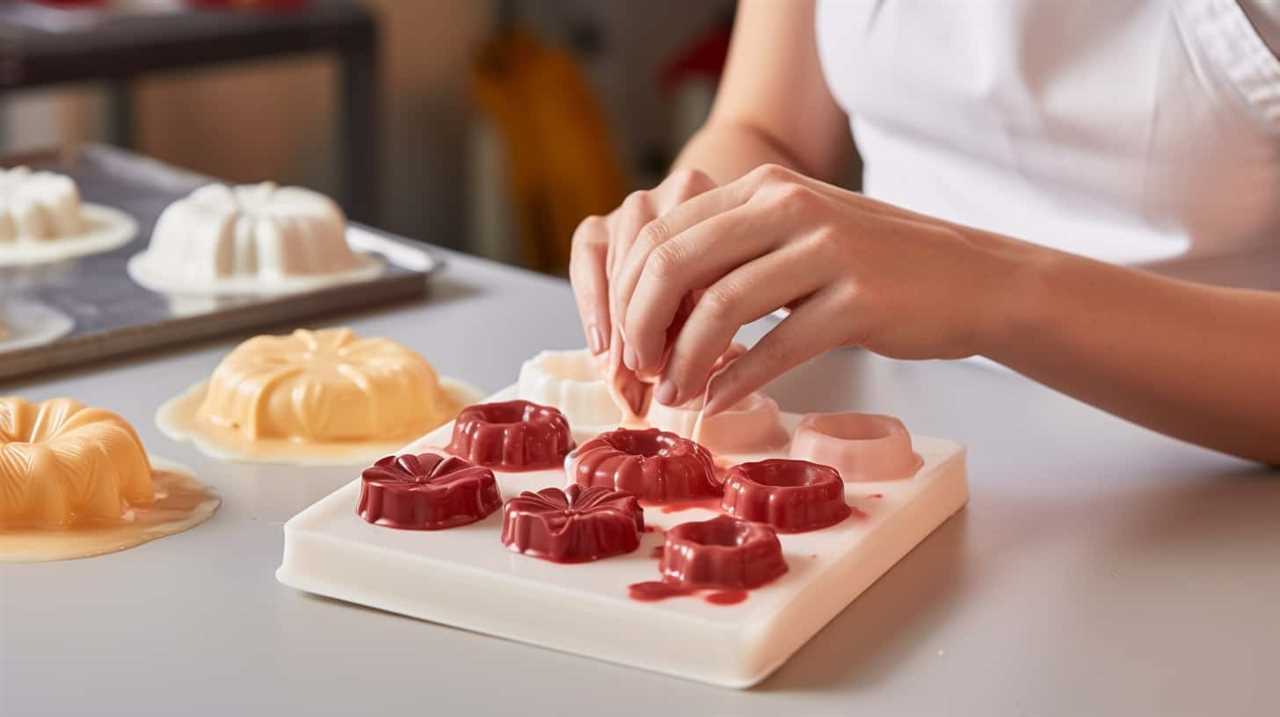
Proper Candle Warmer Usage
To use a candle warmer, we simply place a candle on the warming plate and turn on the device. Proper candle warmer usage is essential for both safety and the longevity of the device. Here are some steps to ensure you’re using your candle warmer correctly:
- Candle warmer safety:
- Always place the candle warmer on a heat-resistant surface to prevent any damage.
- Keep the candle warmer away from flammable materials and out of the reach of children and pets.
- Candle warmer maintenance:
- Regularly clean the warming plate to prevent any buildup of residue.
- Replace the candle when it’s no longer producing a desirable scent or when it reaches the end of its lifespan.
By following these steps, you can enjoy the benefits of your candle warmer while ensuring its safety and longevity.
Now, let’s move on to discussing the safety precautions when using a candle warmer.
Safety Precautions When Using a Candle Warmer
To ensure safe usage of a candle warmer, we should adhere to certain precautions and follow proper steps for operating the device.

Candle warmer maintenance is crucial in order to prevent accidents and ensure the longevity of the device. Before using a candle warmer, it’s important to read and follow the manufacturer’s instructions carefully.
Always place the candle warmer on a stable surface away from flammable materials and keep it out of reach of children and pets. Never leave a candle warmer unattended and always extinguish the candle before leaving the room.
It’s also important to regularly clean the candle warmer to remove any residue or buildup. By following these safety precautions and properly maintaining your candle warmer, you can enjoy the benefits of a cozy and inviting atmosphere without compromising safety.
Can You Use a Candle Warmer With Scented Candles
Yes, we can use a candle warmer with scented candles. Candle warmers are versatile and can be used with different types of candles, including scented ones. Here are some benefits of using scented candles with a candle warmer:
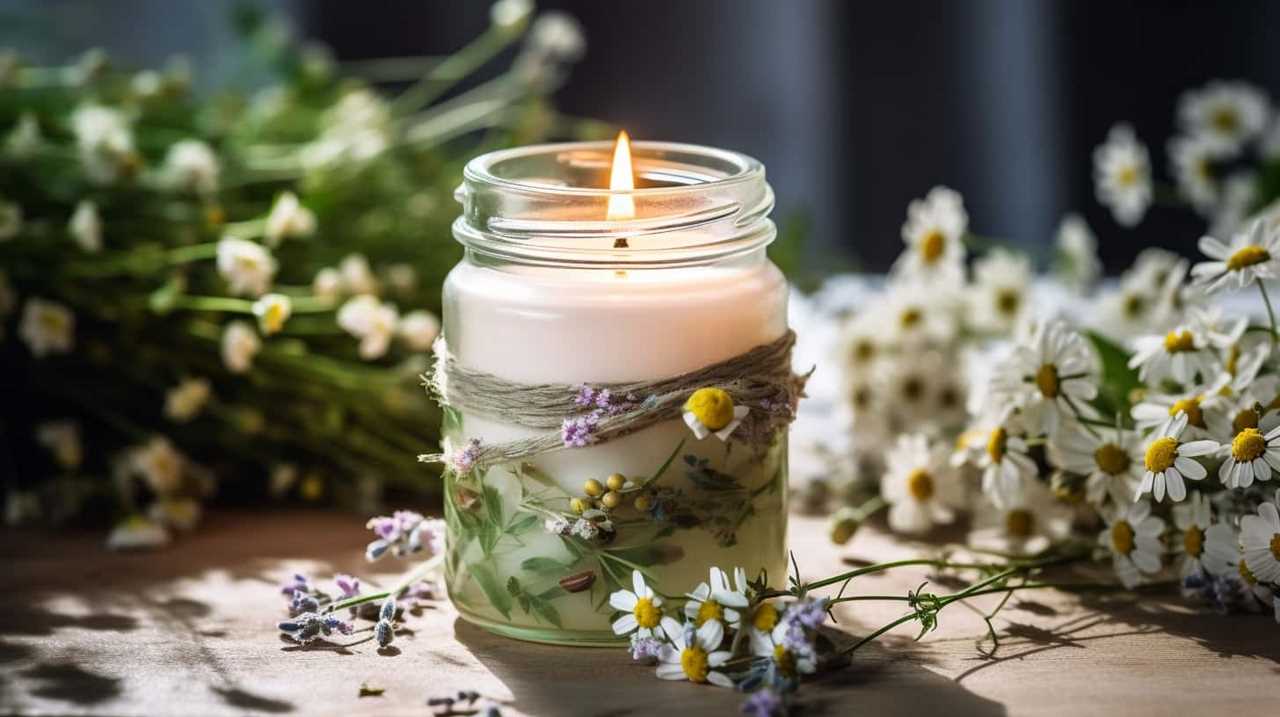
- Enhanced fragrance: When you use a candle warmer with scented candles, the heat gently releases the fragrance, filling the room with a delightful aroma. The scent is more consistent and long-lasting compared to traditional burning methods.
- Safe and flameless: Using a candle warmer eliminates the need for an open flame, reducing the risk of accidents. This is especially beneficial if you have children or pets in your home.
Using a candle warmer with scented candles allows you to enjoy the beautiful scent without any worry or hassle. It enhances the ambiance of your space and creates a relaxing atmosphere. So go ahead, indulge in the luxury of scented candles with the convenience of a candle warmer.
Candle Warmer Safety Tips
Here are some important safety tips to keep in mind when using a candle warmer:
| Safety Tips | Description |
|---|---|
| Place on a Heat-Resistant Surface | Always place your candle warmer on a heat-resistant surface to prevent any potential damage or fire hazards. |
| Keep Away from Flammable Materials | Ensure that there are no flammable materials or substances near the candle warmer to avoid any accidents or fires. |
| Use a Timer | Consider using a timer to automatically turn off the candle warmer after a certain period of time. This helps prevent overheating and reduces the risk of accidents. |
When using a candle warmer, it is crucial to prioritize safety to prevent any mishaps or accidents. By following these safety tips, you can enjoy the warm glow and fragrance of your candles without any worries. For more information on candle warmers, check out our candle warmer buying guide. And if you’re looking for gift ideas, consider a candle warmer for your loved ones to enhance their candle experience while keeping safety in mind.
Extending the Lifespan of a Candle Warmer
How can we effectively extend the lifespan of a candle warmer? By following a few simple steps, we can maximize the performance and longevity of this beloved device. Here are some tips to help you extend the life of your candle warmer:

- Clean regularly: Regularly clean the surface of your candle warmer to prevent any buildup of wax or residue that could affect its performance.
- Use quality candles: Opt for high-quality candles made from natural ingredients. These candles burn cleaner and longer, resulting in a longer lifespan for your candle warmer.
- Trim the wick: Before placing a candle on the warmer, make sure to trim the wick to about 1/4 inch. This will prevent excessive soot and ensure a more efficient burn.
- Adjust temperature: Experiment with different temperature settings on your candle warmer to find the optimal level for maximizing fragrance and extending the life of your candle.
Cleaning and Maintaining a Candle Warmer
To properly clean and maintain a candle warmer, we recommend following a simple three-step process. First, ensure that the warmer is unplugged and has cooled down completely before cleaning. This will prevent any accidents or burns. Next, wipe the surface of the warmer with a soft cloth or sponge dampened with warm soapy water. Be sure to remove any wax residue or buildup. Finally, dry the warmer thoroughly before plugging it back in. Regular cleaning and maintenance will not only keep your candle warmer looking its best, but also ensure its longevity and optimal performance. Here are some cleaning tips and maintenance techniques to keep in mind:
| Cleaning Tips | Maintenance Techniques |
|---|---|
| Use a gentle cleaner | Inspect cords for damage |
| Avoid abrasive materials | Check for loose parts |
| Clean regularly | Keep away from water |
Using a Candle Warmer for Aromatherapy
When it comes to using a candle warmer for aromatherapy, there are several benefits to consider.
Aromatherapy has been known to promote relaxation, reduce stress, and improve mood.
By using a candle warmer, the heat gently releases the fragrance of the essential oils, effectively dispersing the scent throughout the room for maximum effectiveness.

Experimenting with different scents can help you find the perfect aroma to create a calming and soothing ambiance in your space.
Benefits of Aromatherapy
Aromatherapy offers numerous benefits for us when using a candle warmer. By harnessing the power of essential oils, we can experience a wide range of physical and emotional benefits. Here are some of the key benefits of aromatherapy:
- Stress Relief:
- Essential oils such as lavender, chamomile, and bergamot have calming properties that can help reduce stress and anxiety.
- Aromatherapy can promote relaxation and improve sleep quality, allowing us to unwind after a long day.
- Emotional Well-being:
- Certain essential oils, like citrus oils and peppermint, have uplifting and energizing effects that can boost mood and improve mental clarity.
- Aromatherapy can also help alleviate symptoms of depression and enhance overall emotional well-being.
Using a candle warmer for aromatherapy allows us to enjoy these benefits conveniently and safely. It creates a soothing ambiance while releasing the therapeutic properties of essential oils into the air, promoting a sense of tranquility and balance in our lives.
Candle Warmer Effectiveness
As we continue exploring the benefits of aromatherapy, it is important to understand the effectiveness of using a candle warmer for this purpose. Candle warmers are a popular choice for aromatherapy enthusiasts because they provide a safe and convenient way to release the therapeutic scents of essential oils without the need for an open flame.

To emphasize the effectiveness of candle warmers for aromatherapy, let’s take a look at the following table:
| Candle Warmer Safety | Candle Warmer Maintenance |
|---|---|
| Keep out of reach of children and pets | Clean the warmer regularly to remove any residue or buildup |
| Place the warmer on a stable surface away from flammable objects | Replace the bulb or heating element as needed |
| Never leave the warmer unattended | Store the warmer in a cool, dry place when not in use |
| Follow the manufacturer’s instructions for proper use | Check for any signs of wear or damage before each use |
By following these safety guidelines and properly maintaining your candle warmer, you can ensure its effectiveness and enjoy the benefits of aromatherapy with peace of mind.
Now, let’s explore different scents for relaxation.
Different Scents for Relaxation
To enhance the effectiveness of our candle warmer for aromatherapy, let’s now explore the different scents that promote relaxation. Aromatherapy has long been recognized for its ability to calm the mind, reduce stress, and create a soothing atmosphere. Here are some popular scents that can help you relax and unwind:
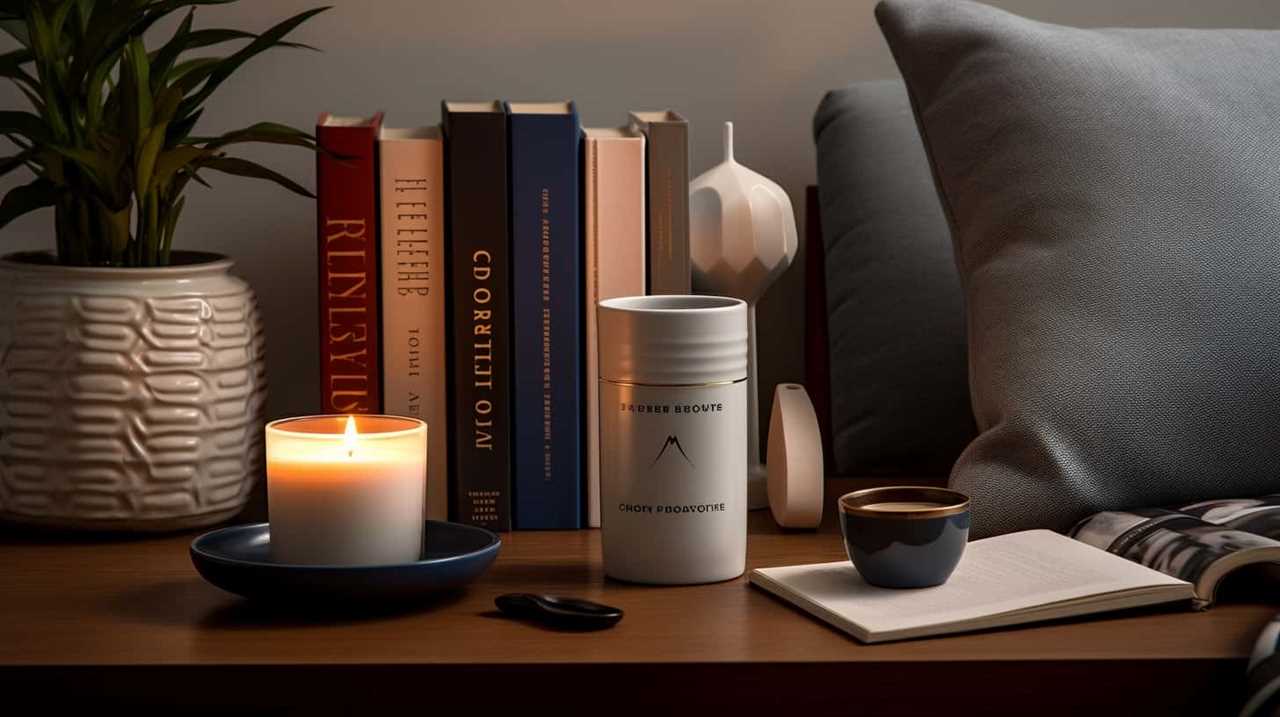
- Lavender: Known for its calming properties, lavender helps to relieve anxiety and promote a sense of tranquility.
- Chamomile: This gentle scent is perfect for relaxation, as it helps to calm the nerves and promote better sleep.
- Bergamot: With its citrusy and floral aroma, bergamot uplifts the mood and reduces stress.
- Ylang Ylang: This exotic scent is known for its ability to relieve tension and promote feelings of happiness and relaxation.
- Sandalwood: A warm and woody fragrance, sandalwood helps to calm the mind and enhance mental clarity.
Using these different scents for relaxation can provide numerous benefits of aromatherapy, such as reducing stress, improving sleep quality, and creating a peaceful environment for ultimate relaxation.
Frequently Asked Questions About Candle Warmers
We often receive questions about candle warmers and how they work. Candle warmer maintenance is an important part of keeping your candle warmer functioning properly. It’s recommended to clean the warmer regularly to remove any residue or buildup from the wax. This can be done by allowing the warmer to cool completely, then wiping it with a soft cloth or paper towel.
Additionally, always remember to follow candle warmer safety tips to ensure a safe and enjoyable experience. These tips include placing the warmer on a heat-resistant surface, keeping it away from flammable materials, and never leaving it unattended while in use.
By following these maintenance and safety guidelines, you can prolong the lifespan of your candle warmer and prevent any potential accidents.

Now, let’s move on to troubleshooting common candle warmer issues.
Troubleshooting Common Candle Warmer Issues
Let’s dive into some common issues that can arise with candle warmers and how to troubleshoot them.
When it comes to troubleshooting candle warmer problems, it’s important to identify the common candle warmer malfunctions and find effective solutions. Here are two sub-lists that will help you resolve these issues and ensure a smooth candle warming experience:
- Burner not heating up:
- Check if the power cord is properly plugged in.
- Ensure that the outlet is working by testing it with another device.
- If the cord is damaged, replace it with a new one.
- Clean the burner plate to remove any debris that may be blocking the heat.
- Uneven heat distribution:
- Adjust the position of the candle warmer to ensure it’s centered on the plate.
- Use a candle warmer with a larger plate for better heat distribution.
- Consider using a candle warmer with a built-in temperature control feature.
- Avoid using candles with a high melting point as they may not distribute heat evenly.
Frequently Asked Questions
What Are the Different Types of Candle Warmers Available in the Market?
There are various types of candle warmers available in the market, each offering unique benefits. They provide a safe and efficient way to enjoy the fragrance of candles without the risk of an open flame.

Can Candle Warmers Be Used With All Types of Candles?
Using candle warmers with different types of candles has pros and cons. Benefits include longer lasting fragrance and safer, flameless operation. However, not all candles are suitable, as some may not melt evenly or release their fragrance effectively.
How Long Does It Take for a Candle to Fully Melt Using a Candle Warmer?
Using a candle warmer, it typically takes about 1-2 hours for a candle to fully melt. The temperature of the warmer is set at a safe level to slowly and evenly melt the wax. The benefits of using a candle warmer include a longer-lasting fragrance and no open flame.
Are There Any Safety Precautions to Keep in Mind While Using a Candle Warmer?
Safety precautions are crucial when using a candle warmer. To avoid accidents, remember to never leave it unattended, keep it away from flammable materials, and always follow the manufacturer’s instructions for proper usage.
Can Candle Warmers Be Used for Aromatherapy Purposes With Essential Oils?
Candle warmers can be used for aromatherapy purposes with the best essential oils for maximum benefits. The gentle heat from the warmer helps release the fragrance of the oils, creating a soothing and relaxing environment.
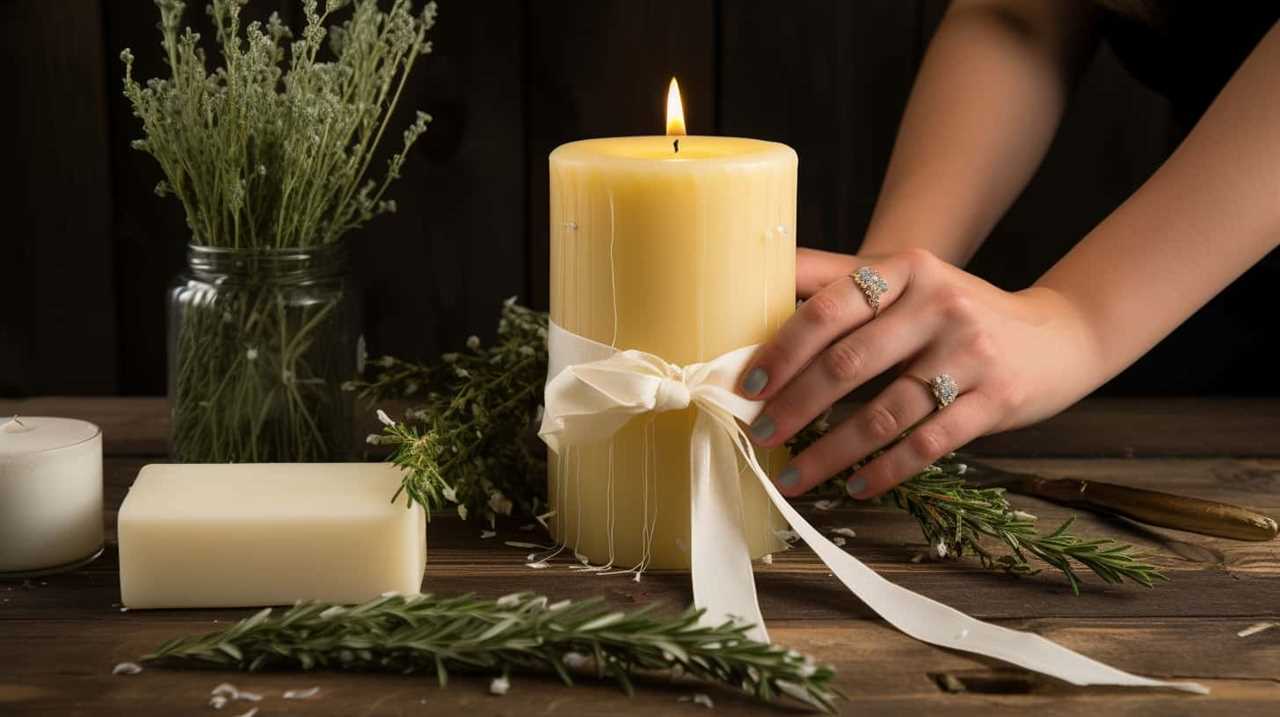
Conclusion
In conclusion, candle warmers are a safe and effective way to enjoy the beautiful scents of candles without the risk of an open flame.
One interesting statistic to note is that candle warmers can provide up to 200 hours of fragrance per candle, making them a cost-effective choice for those who love a cozy and inviting atmosphere in their homes.
So why not give a candle warmer a try and experience the warmth and aroma it can bring to your space?

